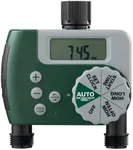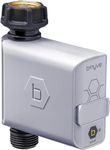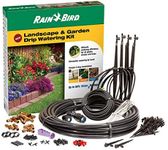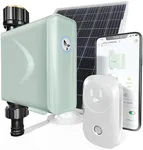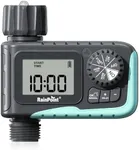Buying Guide for the Best Drip Irrigation Timer
Choosing the right drip irrigation timer can make a significant difference in the efficiency and effectiveness of your watering system. A drip irrigation timer automates the watering process, ensuring your plants get the right amount of water at the right time. This not only saves you time but also conserves water and promotes healthier plant growth. When selecting a drip irrigation timer, consider the following key specifications to find the best fit for your needs.Number of ZonesThe number of zones refers to the different areas or sections of your garden that the timer can control independently. This is important because different plants may have different watering needs. Timers typically range from single-zone to multi-zone (up to 12 or more). If you have a small garden or a single type of plant, a single-zone timer may suffice. For larger gardens with diverse plant types, a multi-zone timer allows you to customize watering schedules for each area.
Programming FlexibilityProgramming flexibility refers to how customizable the watering schedules are. This includes the ability to set different start times, durations, and frequencies. More advanced timers offer features like multiple start times per day, specific days of the week, and even seasonal adjustments. If you have a simple garden setup, basic programming might be enough. However, for more complex gardens with varying watering needs, look for a timer with advanced programming options to ensure each plant gets the right amount of water.
Power SourceDrip irrigation timers can be powered by batteries, solar energy, or a direct electrical connection. The power source is important for reliability and convenience. Battery-powered timers are easy to install and portable but require regular battery changes. Solar-powered timers are eco-friendly and reduce the need for battery replacements, but they need sufficient sunlight to function properly. Electric timers offer consistent power but require a nearby power outlet and more complex installation. Choose a power source that fits your garden setup and maintenance preferences.
Watering Duration and FrequencyWatering duration and frequency settings determine how long and how often your plants are watered. This is crucial for ensuring plants receive the right amount of water without overwatering or underwatering. Basic timers may offer fixed durations and frequencies, while advanced models allow for more precise control. If your plants have specific watering needs, opt for a timer that allows you to set exact durations and frequencies. For general use, a timer with a range of preset options might be sufficient.
Weather Sensing and Smart FeaturesSome drip irrigation timers come with weather sensing and smart features that adjust watering schedules based on real-time weather conditions. This can include rain sensors, soil moisture sensors, and integration with weather forecasts. These features help conserve water and prevent overwatering during rainy periods. If you live in an area with variable weather or want to optimize water usage, consider a timer with these smart features. For more predictable climates, a standard timer without these features may be adequate.
Ease of Use and InstallationEase of use and installation refers to how user-friendly the timer is and how simple it is to set up. This includes intuitive controls, clear displays, and straightforward installation processes. Some timers come with app control for added convenience. If you're not tech-savvy or prefer a hassle-free setup, look for a timer with simple, easy-to-understand controls and instructions. For those comfortable with technology, a timer with app integration and advanced features might be more appealing.


![[Upgraded Version] Sprinkler Timer](https://images-proxy.bestreviews.guide/B4KdgTr26QCylEcZOvf3EAxlLLI=/0x150/https://m.media-amazon.com/images/I/41-n4JKozCL._AC_CX679_.jpg)

